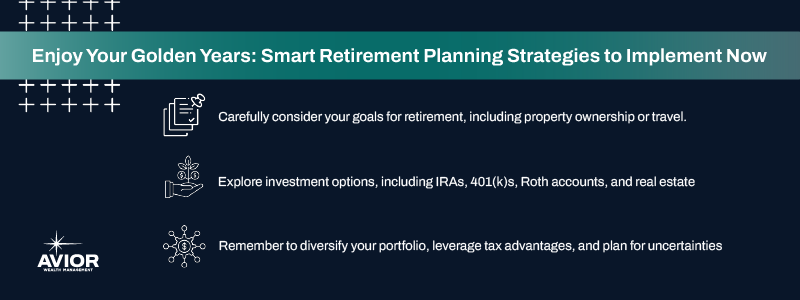Enjoy Your Golden Years: Smart Retirement Planning Strategies to Implement Now
Planning for retirement requires setting goals for your future, examining investment options, and considering tax implications.

Careful retirement planning is a must for wealth preservation, especially when considering extended lifespans, economic unpredictability, and shifting familial goals. However, you may be grappling with a range of challenges, from deciphering the myriad different investment options to aligning your current needs with your long-term retirement goals.
We all need accessible strategies for retirement planning, tailored to our different life stages and financial situations. This post delves into the pivotal role of retirement planning, covering how to set goals, explore investment options, harness the right strategies, and manage risks.
Assessing your needs for retirement
First, get crystal clear on your retirement goals. Otherwise, you won’t know how much you’ll need when retirement comes. Consider the monthly expenses you’ll likely have in retirement (a mortgage, children’s higher education, recurring bills, etc.) and whether you’ll have more or less funds than you have now. What does that mean for your income requirements?
Also, consider personal goals like investing in real estate, traveling, or downsizing, which will impact your savings approach. You can then begin to estimate how much income you’ll need every month. You can either bring this number to a financial advisor or work with one to figure it out together. They can then help you set up an investment plan to make that number a reality in retirement.
Next, you’re ready to consider investment options.
Exploring retirement investment options
Every investor will have different goals for retirement, so each strategy is different. However, learning about all your options allows you and your advisor to create the right balance to help you achieve desired outcomes and wealth preservation. Here are several common retirement investment options:
- Employer-sponsored plans: These will be the 401(k)s and 403(b)s. These plans are sponsored by an employer, and allow you to avoid paying taxes on contributions now (though you’ll have to pay them later). The contribution limit for 2023 is $22,500, and people over 50 can make an additional contribution of $7,500. People between 60 and 63 can make an additional $10,000 contribution annually starting in 2025. Employers often match your monthly contributions to these plans, which is a major benefit.
- Individual retirement accounts (IRAs): IRAs are flexible savings options. You don’t have to have an employer-sponsored plan and can contribute on your own. For 2023, the annual contribution limit is $6,500 for an IRA, and people over 50 can contribute an extra $1,000. Traditional IRAs allow you to avoid paying taxes on contributions now, but you’ll have to pay taxes on withdrawals later. With a Roth IRA, you pay taxes on your contributions now but avoid taxes on your income in retirement.
- Bonds and cash: If you don’t want to take a lot of risk with the market, cash and bonds are safer savings options. These can be smart choices the closer you get to retirement so you’re not risking big losses.
- Stocks: The stock market is always fluctuating. Investing in stocks means that your money will likely see ups and downs over the years, but it has the potential for significant growth over time.
- Real estate and alternative investments: Many investors decide to diversify with real estate and other alternative investments like art or wine for a fruitful retirement. These alternatives can help you protect your savings from one type of market swing.
Each of these options has different tax implications, so tax planning should be part of your discussion with your Avior tax advisor. These options also have different annual limits and rules for retirement distributions.
The goal is to maximize your retirement savings with the right mix of investments while accounting for your comfort level with risk. This takes the right strategy, discussed next.
Five strategies to maximize your retirement savings.
Now, how do you accomplish the right balance to maximize savings? These five tips will help build out your strategy:
1. Diversify
It’s almost always recommended that a portfolio includes more than one type of investment. Diversification is wise because if one area of the market dips, like the stock market, you have assets invested elsewhere that aren’t impacted.
2. Leverage tax-advantaged accounts
Decide what your tax strategy will be for tax-advantaged accounts. Traditional IRAs and 401(k)s offer the tax benefit of avoiding paying taxes now but paying in retirement when you withdraw the funds. Roth accounts require you to pay taxes now, but not in retirement. So, consider when you will have more income and be in a higher tax bracket.
3. Determine your risk comfort level
The amount of risk you want to take on, and where you are in life, will also inform your investment portfolio. For example, the closer you get to retirement, the less you may want to put into the stock market. It’s riskier than other investments, so you want to have plenty of time to recoup losses.
Think through your comfort level with risk when creating an investment strategy and how it may change over time.
4. Plan for uncertainties
The path of life is anything but certain. A smart retirement plan accounts for these uncertainties. For example, you may have to deal with an expensive healthcare issue later in life. Remember that inflation will continue to rise over the years. And, you never know what the market will do.
While you can’t predict the future, you can create a balanced portfolio that will protect you against surprises and help you manage risk.
5. Review and adjust your plan regularly
Your retirement plan shouldn’t be created and then never reviewed again. While your investments will earn money for you with the market, you still need to regularly review how everything is performing. If your goals or plans change, you’ll want to carefully reconsider where your investments are going. For example, if you experience a change in income or family circumstances, you will likely need to adjust plans.
Think of retirement planning as an ongoing component of lifetime wealth management.
Commit to a secure retirement with Avior
Taking the step to plan for retirement means you’re already on the right path toward the lifestyle you want for yourself and your loved ones. Remember to consider your options, your comfort level with risk, and your goals for your life in retirement. Tax implications abound with investments, so always stay up to date on changing tax laws.
An experienced financial advisor can help you make the right retirement planning decisions. They will guide you and help you set goals, creating a portfolio that is balanced to meet your objectives and aligned with your desired risk.
Find an advisor at Avior to learn about our expert retirement planning services.
Disclaimer: Nothing contained herein should be construed as legal or tax advice. Avior and our Advisors will work with your attorney and/or tax professional to assist with your legal and tax strategies. Please consult your attorney or tax professional with specific legal and/or tax questions. Investment Management and Financial Planner are offered through Avior Wealth Management, LLC, an SEC-registered investment advisor. Past performance is not a guarantee of future results. Investments are subject to loss, including the loss of principal.
No Comments
Sorry, the comment form is closed at this time.




